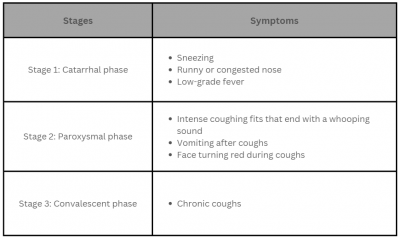The numbers of pertussis cases in Malaysia are showing an upward trend in the last decade. This is a huge concern since infants and young children are vulnerable to the disease.

Reference: World Health Organization (WHO)1
Data from the World Health Organization (WHO) shows how pertussis cases in Malaysia started to rise in 2011 after staying below 100 since 1988.1 In fact, a total of 42 deaths were reported during the peak in 2018-2019.2 The majority of the cases happened to infants who were yet to receive their scheduled immunisation at 2 months old and unvaccinated young children.2 Although there is a decrease in 2020-2021 due to the COVID-19 lockdown, the issue remains a major concern as borders have reopened and the world is returning back to normal. But what do you know about pertussis?
Whooping cough
Pertussis is a highly contagious respiratory infection typically caused by the bacteria Bordetella pertussis and is characterised by intense coughing fits.3, 4 It is also known as “whooping cough” because of the high-pitched “whoop” sound made as people gasp for air after a coughing fit.3 However, do note that not everyone will make the sound, especially infants, as they might gasp for air instead during these episodes.3
The disease progresses in three stages, each lasting 1-2 weeks:4

Highly contagious
9 out of 10 susceptible individuals exposed to pertussis may catch the disease, making it a highly contagious disease.4 Pertussis spreads from person to person through the air.3 When an infected person coughs, sneezes, laughs, kisses or hugs another person, he may transmit the disease.3 Babies are usually infected by older siblings, parents or caregivers who have mild symptoms and are unaware that they have pertussis.4
A threat to little ones
Pertussis is dangerous to babies, particularly those under 18 months old, because the coughing spells can cause them to stop breathing.3 They are more likely to have severe disease, develop complications and require hospitalisation.4 Here are some possible complications in babies and young children:3
- Apnoea (pauses in breathing)
- Pneumonia
- Seizures
- Encephalopathy (brain damage or disease)
Older children, teens and adults may also get infected, usually with milder symptoms.4 However, complications may arise too due to severe coughing, e.g. fainting, trouble sleeping, incontinence, rib fractures and pneumonia.3, 4
Reducing the burden of pertussis
Two types of vaccines are available to protect ourselves against pertussis: DTaP (diphtheria-tetanus-acellular-pertussis vaccine) and Tdap (tetanus-diphtheria-acellular-pertussis vaccine). These vaccines also protect against tetanus and diphtheria.
Currently, vaccination against diphtheria, tetanus and pertussis is included in the national immunisation programme and given as a 6-in-1 shot (DTaP-IPV-HepB-Hib) at the age of 2, 3, 5 and 18 months.5
Plus, older children, teens and adults can receive a booster dose of Tdap every 10 years because their immunity can wane over time.6 Older children can get the vaccine between the ages of 11 to 12 years.3
In addition, pregnant women can also receive the Tdap vaccine during the early part of the 3rd trimester of each pregnancy. Antibodies created after maternal vaccination will be passed to the baby during pregnancy, thus providing some protection against pertussis during the first months of life.4, 6
Other preventive measures should also be practised if someone in the household has pertussis. They should cover their mouth properly when they cough or consider wearing a face mask. Proper handwashing is also key to prevent the spread of pertussis.3
Before the introduction of vaccines, pertussis used to be the leading cause of infant death. Worldwide vaccination has managed to reduce the number.4 However, we have discovered that the pertussis protection by DTaP vaccines wanes over time, hence the need to have another Tdap booster shot. Complete, on-time infant vaccination, complemented with maternal vaccination, is important to reduce the burden of pertussis among infants and young children. Parents and pregnant women are advised to contact their doctors to learn more.
References:
- World Health Organization. (2022, July 15). Global Health Observatory data repository – Pertussis Reported cases by country. World Health Organization. Retrieved March 17, 2023, from https://apps.who.int/gho/data/view.main.1540_43?lang=en
- Director General of Health. (2020, April 24). Kenyataan Akhbar KPK 24 April 2020 – Minggu Imunisasi Kebangsaan 24 – 30 April 2020 (World Immunization Week 2020). From the Desk of the Director-General of Health Malaysia. Retrieved March 17, 2023, from https://kpkesihatan.com/2020/04/24/kenyataan-akhbar-kpk-24-april-2020-minggu-imunisasi-kebangsaan-24-30-april-2020-world-immunization-week-2020/
- (n.d.). Whooping cough: Causes, symptoms, treatment and prevention. WebMD. Retrieved March 17, 2023, from https://www.webmd.com/children/whooping-cough-symptoms-treatment
- Bocka, J. J. (2023, January 18). Pertussis. Medscape. Retrieved March 17, 2023, from https://emedicine.medscape.com/article/967268-overview#showall
- (2020, November 18). Malaysia updates child immunisation schedule with hexavalent vaccine. CodeBlue. Retrieved March 17, 2023, from https://codeblue.galencentre.org/2020/11/17/malaysia-updates-child-immunisation-schedule-with-hexavalent-vaccine/
- Lim, V. K. E. (Ed.). (n.d.). Guidelines for Adult Immunisation (3rd ed.). Malaysian Society of Infectious Diseases and Chemotherapy (MSIDC). Retrieved from https://adultimmunisation.msidc.my/wp-content/uploads/2020/12/AIG-3rd-edition-Final-version-09122020-c.pdf






Comments